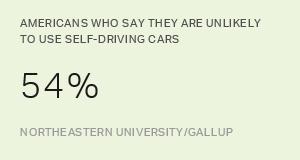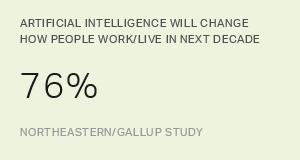Story Highlights
- 85% of Americans use at least one of six products with AI elements
- 84% use navigation apps
- 72% use streaming media services
WASHINGTON, D.C. -- Nearly nine in 10 Americans (85%) say they currently use at least one of six devices, programs or services that feature elements of artificial intelligence (AI). Use of these products ranges from 84% of U.S. adults using navigation applications to 20% using smart home devices such as self-learning thermostats and lighting.

These data come from a Northeastern University/Gallup survey of Americans' attitudes toward artificial intelligence (AI) and its effect on their lives and work. The mail survey of 3,297 U.S. adults was conducted Sept. 15-Oct. 10, 2017. The study found 79% of Americans saying AI has had a very or mostly positive impact on their lives so far.
The percentage of Americans using different consumer AI products may be at least partly related to the length of time these products have been on the market. The most widely used product -- navigation apps, such as Google® Maps, Waze® or Apple® Maps -- has been on the market since the mid-2000s. Streaming media services -- including Netflix®, Hulu®, Pandora® and Spotify® -- which 72% of Americans use, first launched in 1993, though technical limitations with these limited their growth until the mid-2000s. Nearly half of Americans (47%) use digital personal assistants on their smartphones, such as Siri® or Google Voice. The first digital personal assistant launched in 2011.
Beyond the three most widely used products, ride-sharing apps, such as those used for Uber® or Lyft®, which first appeared in 2011, are used by roughly a third of U.S adults. Intelligent home personal assistants -- such as Amazon's® Alexa™ or Google Home™, which use voice commands to search for information online or control elements of their homes -- debuted in 2014. Currently, 22% of U.S. adults report using such devices. Twenty percent of U.S. adults say they use smart home devices, on the market since 2011, when the first learning thermostat was released.
Age, Education Key Factors in Use of Some Products With AI Elements
Americans' use of digital personal assistants on their smartphones, intelligent home personal assistants and smart home devices vary little by demographic subgroup. However, there are differences by subgroup for use of navigation apps, streaming media services and ride-sharing apps, with younger and more educated Americans generally most likely to use these.
| Navigation apps | Streaming media services | Ride-sharing apps | ||||||||||||||||||||||||||||||||||||||||||||||||||||||||||||||||||||||||||||||||||||||||||||||||||
|---|---|---|---|---|---|---|---|---|---|---|---|---|---|---|---|---|---|---|---|---|---|---|---|---|---|---|---|---|---|---|---|---|---|---|---|---|---|---|---|---|---|---|---|---|---|---|---|---|---|---|---|---|---|---|---|---|---|---|---|---|---|---|---|---|---|---|---|---|---|---|---|---|---|---|---|---|---|---|---|---|---|---|---|---|---|---|---|---|---|---|---|---|---|---|---|---|---|---|---|---|
| % | % | % | ||||||||||||||||||||||||||||||||||||||||||||||||||||||||||||||||||||||||||||||||||||||||||||||||||
| Overall | 84 | 72 | 32 | |||||||||||||||||||||||||||||||||||||||||||||||||||||||||||||||||||||||||||||||||||||||||||||||||
| Gender | ||||||||||||||||||||||||||||||||||||||||||||||||||||||||||||||||||||||||||||||||||||||||||||||||||||
| Men | 83 | 68 | 32 | |||||||||||||||||||||||||||||||||||||||||||||||||||||||||||||||||||||||||||||||||||||||||||||||||
| Women | 85 | 75 | 32 | |||||||||||||||||||||||||||||||||||||||||||||||||||||||||||||||||||||||||||||||||||||||||||||||||
| Age | ||||||||||||||||||||||||||||||||||||||||||||||||||||||||||||||||||||||||||||||||||||||||||||||||||||
| 18 to 35 | 94 | 91 | 45 | |||||||||||||||||||||||||||||||||||||||||||||||||||||||||||||||||||||||||||||||||||||||||||||||||
| 36 to 50 | 93 | 84 | 39 | |||||||||||||||||||||||||||||||||||||||||||||||||||||||||||||||||||||||||||||||||||||||||||||||||
| 51 to 65 | 80 | 63 | 26 | |||||||||||||||||||||||||||||||||||||||||||||||||||||||||||||||||||||||||||||||||||||||||||||||||
| 66+ | 66 | 41 | 14 | |||||||||||||||||||||||||||||||||||||||||||||||||||||||||||||||||||||||||||||||||||||||||||||||||
| Education | ||||||||||||||||||||||||||||||||||||||||||||||||||||||||||||||||||||||||||||||||||||||||||||||||||||
| Less than a bachelor's degree | 79 | 67 | 23 | |||||||||||||||||||||||||||||||||||||||||||||||||||||||||||||||||||||||||||||||||||||||||||||||||
| Bachelor's degree or higher | 94 | 82 | 51 | |||||||||||||||||||||||||||||||||||||||||||||||||||||||||||||||||||||||||||||||||||||||||||||||||
| Political party affiliation | ||||||||||||||||||||||||||||||||||||||||||||||||||||||||||||||||||||||||||||||||||||||||||||||||||||
| Republican | 83 | 68 | 27 | |||||||||||||||||||||||||||||||||||||||||||||||||||||||||||||||||||||||||||||||||||||||||||||||||
| Independent | 84 | 71 | 28 | |||||||||||||||||||||||||||||||||||||||||||||||||||||||||||||||||||||||||||||||||||||||||||||||||
| Democrat | 86 | 77 | 43 | |||||||||||||||||||||||||||||||||||||||||||||||||||||||||||||||||||||||||||||||||||||||||||||||||
| NORTHEASTERN UNIVERSITY/GALLUP SURVEY, SEPT. 15-OCT. 10, 2017 | ||||||||||||||||||||||||||||||||||||||||||||||||||||||||||||||||||||||||||||||||||||||||||||||||||||
At least a majority in all key subgroups of Americans use navigation apps. However, use of these is much more common among adults aged 50 and younger -- more than nine in 10 of whom use such apps -- and falls to 80% among those aged 51 to 65 and 66% for those over age 65. Additionally, there is a 15-percentage-point gap in use of navigation apps between college graduates and those without a college degree -- 94% vs. 79%, respectively.
For streaming media use, the decline by age group is more dramatic, with 91% of those aged 18 to 35 using these services. Use falls to 84% among those aged 36 to 50, to 63% for those 51 to 65 and finally to 41% for those over age 65. There is also a 15-point gap in use of streaming media services between college graduates (82%) and those without college degrees (67%).
By age group, use of ride-sharing apps falls from a high of 45% among those 18 to 35, to a low of 14% among those over age 65. There is also a difference in ride-sharing-app use between those with a college degree (51%) and those without one (23%).
Bottom Line
The vast majority of Americans are already using consumer products that employ elements of AI. These products have made it into their homes and vehicles in the form of streaming media services and navigation applications. Even products adopted by a smaller percentage of Americans, such as smart home devices, are already being used by millions. Growth estimates suggest adoption of AI consumer products is likely to grow substantially in the future. Amazon alone predicts its intelligent home assistant, Alexa, will be adopted by 100 million or more people within the next three to five years.
Read the full Northeastern/Gallup report: "Optimism and Anxiety: Views on the Impact of Artificial Intelligence and Higher Education's Response."
Survey Methods
Results for the Northeastern University/Gallup survey on artificial intelligence are based on surveys conducted by mail from Sept. 15-Oct. 10, 2017, with a random sample of 3,297 U.S. adults aged 18 and older. The survey package included an English and a Spanish survey to provide respondents with the flexibility to reply in their preferred language.
Gallup selected the sample of U.S. residents using address-based sampling (ABS), a sampling technique used to select households from a list of all households on file with the United States Postal Service (USPS). Gallup chooses respondents within the household at random based on which household member would have the next birthday. Gallup used a series of postcard reminders to encourage participation in the survey.
Gallup weighted the data to match national demographics of gender, age, education, race, Hispanic ethnicity, education and region.
All reported margins of sampling error include the computed design effects for weighting.
For results based on the total sample of 3,297 U.S. adults, the margin of sampling error is ±2 percentage points at the 95% confidence level.






